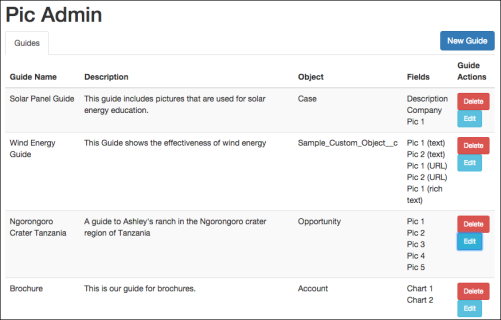Salesforce is a database. Databases love to hold and manage data. Images, though, are “blobs” of unstructured data. They’re big and only contain visual information–no hooks for a database to be able to consume and manage.
We’ve seen a lot of our clients who want to use pictures in Salesforce struggle with this issue. They want to incorporate photos into their workflow, but it’s just too hard to make them jive with the way Salesforce likes to structure data.
What we’ve been working on for a while with our latest app, Pic, is translating standard database stories and making them work with photos. I’ll break down a few of them below–but first, some definitions:
Pic: A picture. Pics exist on records in one of two ways. Either they’ve been added through Chatter or a mobile device, or they’ve been manually loaded through a “slot” Visualforce component from the Salesforce desktop client.
Slot: A slot is a 1:1 image storage location on an object. An example might be a contact record with 1 slot for a picture of the customer. On the back end, a slot is just a text field that stores the image URL. An object can have multiple slots. Multiple image slots work great when you have a predefined template in which all the slots must be populated in order to be rendered correctly.

Guide: A guide is a collection of pics for a specific purpose. It’s a UI component that helps navigate multiple slots easily and from one screen. Guides are great as they give a quick visual reference to multiple slots and allow for quick association with pics on the object.

Set: Synonymous with the word “album,” sets allow for one or more 1:N pics to be arbitrarily associated with an object under a common title or “tag.” Set photos can be managed through the publisher or the mobile UI. Set photos also appear as a related list on your object. Additional data points can be included with each pic record that’s attached, including related object, name, description, comments, and other custom demographics.
So what do you do with all these pics, slots, guides, and sets? Here are 3 simple scenarios that outline some of the database challenges of using pictures in Salesforce and how Pic can help solve them:
Scenario 1
User says: “I want to store a photo in a field.”
Salesforce says: “Attach a pic as a document, copy the URL, and paste to a text field on the object.”
Pic says: “Drop the image into a slot in 2 clicks and Pic will automatically render the URL of the stored document, ready for merging.”
Scenario 2
User says: “I have a marketing slick with spots for 4 photos that we change every time we send it out.”
Salesforce says: “Attach 4 photos, copy each URL, and manually populate 4 text fields on the source records.”
Pic says: “Either upload the photos via Chatter Files or take photos with your mobile device, then use the guides feature to associate the 4 images with the correct slots. Everything else is handled and you can enjoy merging bliss.”
Scenario 3
User says: “I am going to take a bunch of photos–I don’t know how many–and then I need to merge them in a document.”
Salesforce says: “Cough… I really can’t help you there.”
Pic says: “Take as many images as you want, then associate them with a set. The set photos will be available as a related list on your record and they can be merged from there.”
There you have it–the wonder that is Pic! We’ve seen firsthand just how big of a difference Pic makes when it comes to uploading and managing pictures in Salesforce, and that’s why we’re so excited to share it with others. If you want to learn more and get access to Pic in beta mode, contact us today and we’ll hook you up!






